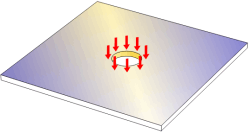Mechanical properties

Suspended ceilings
Mechanical properties including loading capacities and general guidelines for Ecophon grids and ceilings.
Load bearing capacity – ceiling tiles

The basic rule is that no load should be supported by the ceiling tiles. Additional load (lighting, ventilation, etc.) should be supported by the suspension system according to the manufacturers recommendation, or be hung directly from the soffit.
However, Ecophon absorbers in 600x600 mm and 1200x600 mm sizes can take small loads, such as spotlights. The load on the tile must be distributed evenly and respect the limitations set in the table below:
| Format (mm) | Thickness (mm) | Max hole size (mm) | Max load (g) |
| 600x600, 1200x600 | 15 | 100 | 300 |
| 600x600, 1200x600 | 20 | 100 | 500 |
| 600x600, 1200x600 | 40 | 100 | 500 |
For more information regarding integrations with loads, see Connect Bridging
Load bearing capacity – free-hanging units
Ecophon Solo free hanging units, when suspended with wires, can bear small additional loads according to the table below. The load should be evenly distributed and kept at distance from the fixing point. For more information on how to integrate external loads see installation guides: IG402, IG404, IG405, IG406, IG407, IG408, IG410 and IG411.
| Number of fixing points | Max load (kg) |
| 3 | ≤ 1,5 |
| 4 | ≤ 2,0 |
| 6 / 8 | ≤ 4,0 |
- Panels with 3 fixing points: Circle
- Panels with 4 fixing points: Square, Freedom panels with length ≤ 1200mm
- Panels with 6 fixing points: Rectangle panels with size 1800x1200, 2400x600, 2400x1200, Freedom panels with length > 1200mm
- Panels with 8 fixing points: Rectangle panels with size 3000x1200
Load bearing capacity – grids
All Ecophon grid systems have been tested to meet the requirements set by EN 13964:2014 (Table 6) to ensure their load bearing performance and their ability to resist deflection.
The load bearing performance of each Connect product is declared in the Declaration of Performance and on the packaging label.
Max live load (N)
Recommended maximum live load regarding deformation. The numbers refer to point loads, attached to the T-profiles, with at least 1 m separation.
For larger loads attached to the T-profiles, a hanger must be placed directly above.
If the load is evenly distributed along the flanges of the T-profiles, for example in the case of a four sided supported 600x600 mm luminaire, then the load can be increased with 60%. Still a separation of 1 m is required. E.g. when the maximum recommended point load is 50 N, then the total load from a four sided supported luminaire is allowed to be 80 N.
Min load bearing capacity (N)
Required minimum load bearing capacity for the top fixing with at least a 3-folded safety factor.
Stretch fabrics
The mechanical stability of stretched fabrics is characterised by two parameters:
- Tensile strength: measured according to ISO 1421, indicates the maximum stress that the fabric can bear before breaking when it is stretched. It is measured in both warp and weft directions.
- Tear strength: measured according to EN 1875-3, indicates the force required to start or to continue to tear a fabric. It is measured in both warp and weft directions.
Any additional load (such as lighting, ventilation) must not be borne by the stretch fabric and must be hung directly from the soffit.
